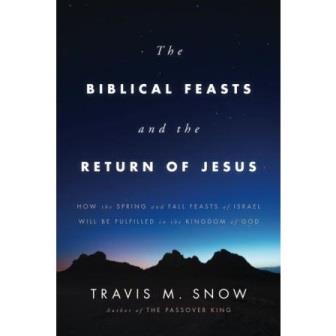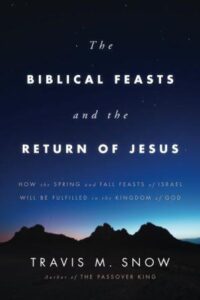The Biblical Feasts, outlined for us in Leviticus 23, occur primarily in the Spring and Fall of the year. The Spring Feasts were fulfilled with the first advent of Yeshua, and the Fall Feasts will be fulfilled when he returns at the Second Coming. Right? That’s the way I’ve been taught, and I’ve probably even said that here at MessianicLight.com. Author Travis Snow sees things a bit differently, and he just might be on to something.
Could it be that, in limiting the prophetic fulfillment of the Spring Feasts (Passover, Unleavened Bread, First Fruits, and Shavuot/Weeks) to the days Messiah Yeshua was here two thousand years ago, we are missing what they say about the future? In The Biblical Feasts and the Return of Jesus, the author presents his case that all of these celebrations, the Spring Feasts and the Fall Feasts, paint a prophetic picture of the Second Coming of the Messiah. This can certainly have a significant impact on our mindset when we meet to observe them.
My first impression after finding this book and before reading it was a little skeptical. Could the traditional understandings really be short sighted after all these years? Surely not – but wait, isn’t that similar to how most of us found this Torah-obedient walk to begin with? Mr. Snow’s perspective is worth considering, and frankly, he is pretty convincing.
The Biblical Feasts and
the Return of Jesus
Travis M. Snow
2023
Kindle Edition – Paperback Edition
The central thesis of The Biblical Feasts and the Return of Jesus is summarized in this sentence from the final chapter describing events that occur after Yeshua has returned:
The Lord redeems His people and defeats their enemies (Passover and Unleavened Bread), provides for them (First Fruits and Weeks), establishes His throne and sanctuary in their midst (Trumpets and Atonement), and thus, during the Feast of Tabernacles, the people can relax and rejoice in the King of kings who rules over them, provides for them, and continues to protect them.
This book begins by immediately stating the author’s premise – the first chapter is simply titled, “Every Feast Is About The Future.” He goes right to Leviticus 23 and then explains the calendar, something important to readers who might not be familiar with the traditional Jewish calendar. And while we may have calendar debates among ourselves in the Hebrew Roots community, this high-level explanation goes into detail on how these Feasts align with the agricultural cycle. Snow does not diminish either their historical significance or how they relate to the first coming of Yeshua as he lays the foundation for what he is about to propose. He states clearly that “the Bible teaches that every feast has three layers of meaning or fulfillment:
- A historical meaning in ancient Israel
- A first-century fulfillment through the work of the Messiah
- A future fulfillment tied to end-time events and the Messiah’s Second Coming”
Mr. Snow then follows this opening chapter with a series of “paired” chapters. The first of each pair describes the historical context of the Feast being discussed. The next chapter discusses how this Feast foreshadows the return of Jesus (Yeshua – the author uses the name “Jesus” throughout this book, which is appropriate for his mixed audience).
The Author’s Approach
In The Biblical Feasts and the Return of Jesus, Travis Snow offers a perspective on the end times that is more pragmatic than what is generally held by most Bible readers. Many of the terms and concepts he uses will already be familiar to those who have come to realize the importance of celebrating the Biblical festivals. The timing and focus of each Feast fulfillment, however, adds a deeper understanding and fills in many of the blanks created in a Fall-Feast-Only second advent.
For example, the typical scenario regarding the Second Coming of the Messiah usually begins with the sound of the trumpet at, appropriately, the Feast of Trumpets on the first day of the seventh month. This author, however, begins just before the first Spring Feast, Passover. And it isn’t necessarily about the date of the Passover, but more a future re-enactment of what led up to the Passover at whatever time that might be. This is followed by the “Second Exodus,” sometimes a hot topic in our circles. But in Snow’s storyline, the Second Exodus is led by Jesus (Yeshua), meaning he has already returned. He presents strong, Biblical support for such an idea and it is really quite fascinating.
He does an excellent job of tying the historical significance of each Feast to how he believes end-time events will unfold. Many explanations rely on rabbinic tradition as well as the Biblical text. The author makes effective use of cultural-religious traditions and understandings in discussions of such topics as the gods of Egypt and the plagues. The historical information is great even if you don’t fully accept his futurist projections.
Mr. Snow presents another interesting understanding of the Tabernacle/Temple as the throne room of God on earth, from which he once ruled and will again rule. This is distinct from a house of worship, and it being the sacred abode of God necessitates some form of ritual cleansing in this polluted world. As for me, I have struggled with any call for rebuilding a Temple now, especially by those who do not acknowledge Yeshua. But as Snow lays this out, a Temple is not built until after Yeshua has returned to Jerusalem, and Yeshua is actually the one who oversees the construction. Perhaps that is a concept I can get behind.
Establishing the millennial reign of Messiah begins with his coronation, and that, according to the author, is the purpose of the Feast of Trumpets. He emphatically draws on Biblical history and on Jewish tradition to establish the pattern for how this takes place in Jerusalem after the city has been liberated from the rule of the antichrist. Finalizing his end-times scenario is the fulfillment of the Feast of Tabernacles, incorporating both the redeemed in their glorified bodies and survivors of the Great Tribulation still in mortal bodies.
A Few Concerns For Me
These aren’t show-stoppers, but there are some things that will, of course, require more study. And, there are some things that I, personally, don’t accept – at least, not right now. It is very helpful to understand where the author is coming from and some of the things that are assumed.
First, Mr. Snow does not waste time or space defending things that either are not critical at all or are so important that, if you don’t believe them, the rest is irrelevant. This book is a straightforward read. As stated earlier, he accepts the standard Jewish (Hillel) calendar, which is one of those non-critical things. He takes, without explanation, a pre-millennial position, and any other view just doesn’t fit. His position assumes a lot of contemporary Christian eschatology such as a future fulfillment of Daniel’s 70th week. And though it also is not critical, Mr. Snow personally holds to a “pre-wrath rapture” similar to that explained by Marvin Rosenthal. His views on the Godhead are trinitarian.
There are a few references to things in other writings by the author. Wisely he doesn’t use a lot of space re-writing those things, and I’ll likely go ahead and get one or two of them. The ideas presented here are not lost by not having them, and his thoughts are generally pretty easy to follow.
Notably missing, and I’m not quite sure why, is any mention of Shemini Atzeret, the Eighth Day Assembly that follows the Feast of Tabernacles. As I was reading the final chapter, The Feast of Tabernacles & The Return of Jesus, when I got to the end I expected to move on to the Eighth Day. Instead, this book ends with moving “deeper and deeper into the glorious days of the millennium.” I’m left wondering what happens when that has concluded.
Personal Reflections
Like most in this walk who might be reading reading this review, I think I have a pretty good grasp on the Biblical Feasts. They aren’t something we view from a distance; we anticipate their arrival every year and actively participate in the celebrations. We know the historical aspects, and can pretty easily explain the highlights of their prophetic fulfillment, at least the way we have come to understand them. But we must never close the door on learning more or considering a different perspective. That’s what this book offers.
Eschatology is a fascinating and challenging subject. We often formulate some kind of timeline, however that can causes us to miss other possible scenarios. And it seems like there is always something that doesn’t fit or gets left out. The Biblical Feasts and the Return of Jesus will show you a different sequence of events, and I still think there are some things that, at least in my mind, just don’t seem to fit. This one isn’t perfect, but it is certainly worth consideration.
For me, two major things I’ve struggled with are 1) what we call the “Greater Exodus” or “Second Exodus,” and 2) the rebuilding of a physical Temple. I’ve read the prevailing views on both and looked at some alternatives. If the explanation presented by Travis Snow is on target, it helps to bring both of those concepts into focus. And, it makes sense to me. But that is something you will need to evaluate yourself.
I can highly recommend The Biblical Feasts and the Return of Jesus by Travis M. Snow. It will definitely challenge the status quo.
About the Author
This is from the author page at Amazon:
Travis M. Snow is the Founder and President of Shiloh Media, a nonprofit Bible teaching and evangelism ministry. He holds an MDiv in Biblical Studies from the Regent University School of Divinity, a BA in Jewish Studies from the Moody Bible Institute, and a Certificate in Messianic Jewish Studies from Israel College of the Bible.
Here are more books by Travis M. Snow:
The 70 Weeks Jubilee: Israel, the Messiah, and the End of the Age in Daniel 9:24-27


